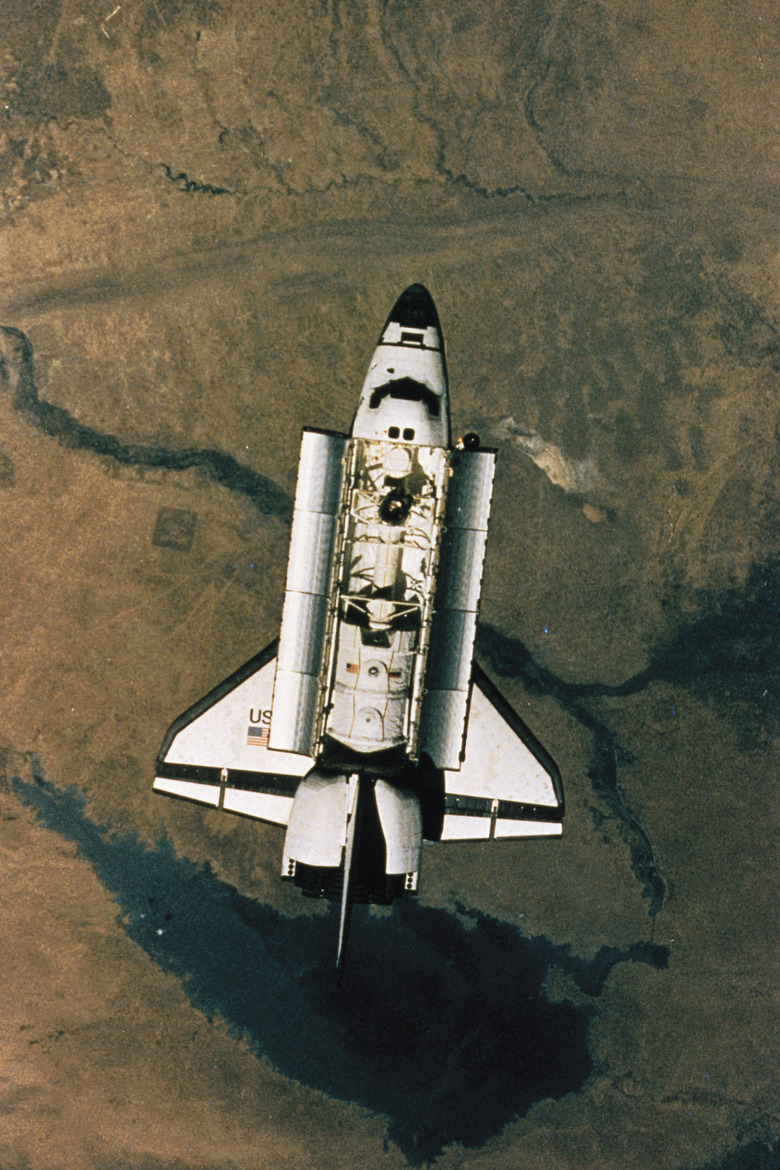Facts On Reentry Into The Earth's Atmosphere
One of the most difficult problems that spacecraft engineers have to solve is that of re-entry into the Earth's atmosphere. Unlike most space debris, which burns up as it encounters the interface between the atmosphere and space, a spacecraft must remain intact and cool during this encounter so that it can return to the ground in one piece. Engineers must balance powerful forces in their considerations in order to achieve this objective and avert disaster.
The Dynamics of Deceleration
The Dynamics of Deceleration
In order to be in orbit in the first place, a spacecraft or satellite must have achieved escape velocity. This velocity, dependent on the Earth's mass and radius, is on the order of 40,000 kilometers per hour (25,000 miles per hour). When the object enters the upper extremities of the atmosphere, the frictional interaction with air molecules begins to slow it down, and the lost momentum gets converted into heat. Temperatures can reach 1,650 degrees Celsius (3,000 degrees Fahrenheit), and the force of deceleration can be seven or more times greater than the force of gravity.
Re-entry Corridor
Re-entry Corridor
The force of deceleration and the heat generated during re-entry increase with the steepness of the angle relative to the atmosphere. If the angle is too steep, the spacecraft burns up, and anyone unlucky enough to be inside is crushed. If the angle is too shallow, on the other hand, the spacecraft skims off the edge of the atmosphere like a stone skimming along the surface of a pond. The ideal re-entry trajectory is a narrow band between these two extremes. The angle of re-entry for the space shuttle was 40 degrees.
The Forces of Gravity, Drag and Lift
The Forces of Gravity, Drag and Lift
During re-entry, a spacecraft experiences at least three competing forces. The force of gravity is a function of the spacecraft's mass, while the other two forces depend on its velocity. Drag, which is caused by air friction, also depends on how streamlined the craft is, and on the air density; a blunt object slows down more quickly than a pointed one, and deceleration increases as the object descends. A spacecraft with the proper aerodynamic design, such as the space shuttle, also experiences a lift force perpendicular to its motion. This force, as anyone familiar with airplanes knows, counteracts the force of gravity, and space shuttle utilized it for this purpose.
Uncontrolled Re-entries
Uncontrolled Re-entries
In 2012, roughly 3,000 objects weighing 500 kilograms (1,100 pounds) were in orbit around the Earth, and all will eventually re-enter the atmosphere. Because they aren't designed for re-entry, they break up at an altitude of 70 to 80 kilometers (45 to 50 miles), and all but 10 percent to 40 percent of the pieces burn up. The pieces that make it to the ground are typically those made from metals with high melting points, such as titanium and stainless steel. Changing weather and solar conditions affect atmospheric drag, making it impossible to predict with certainty where they land.
Cite This Article
MLA
Deziel, Chris. "Facts On Reentry Into The Earth's Atmosphere" sciencing.com, https://www.sciencing.com/reentry-earths-atmosphere-6679/. 24 April 2017.
APA
Deziel, Chris. (2017, April 24). Facts On Reentry Into The Earth's Atmosphere. sciencing.com. Retrieved from https://www.sciencing.com/reentry-earths-atmosphere-6679/
Chicago
Deziel, Chris. Facts On Reentry Into The Earth's Atmosphere last modified August 30, 2022. https://www.sciencing.com/reentry-earths-atmosphere-6679/
